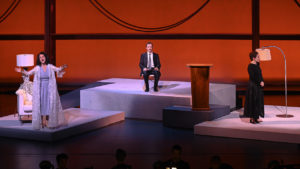
Berkshire Opera Festival 2022 Review: Three Decembers
‘A Devastating Tragedy that Rips Your Heart From Your Chest’
By Chris RuelPhotos by Matt Madison-Clark
This review is of the July 23, 2022, Berkshire Opera Fest Performance
“At the heart of what we do is produce the greatest opera at the highest level. The Berkshires is a magical place. There was a void of opera, and so here we are,” Jonathon Loy, Berkshire Opera Fest’s (BOF) Co-founder and Director of Production, told OperaWire in 2017.
BOF’s staging of “Three Decembers” met the Festival’s mission. It was great opera performed at the highest level.
The Berkshires, in western Massachusetts, is about three hours north of New York City. Its verdant rolling hills have been a vacation spot for Downstate city-dwellers, not only for its picturesque charm but for its vibrant arts scene. The area boasts a Shakespeare company, several theaters, dance organizations, performing arts centers, galleries, antiques, and bed and breakfasts. The region is also home to one of the most famous music venues in the United States, Tanglewood, the summer residence of the Boston Symphony Orchestra and Boston Pops.
To Loy’s point, opera was missing. In 2014, Loy, who has done stints as a stage director at Opera Las Vegas, Center City Opera Theater, Opera Fairbanks, and the Metropolitan Opera as Guest and Staging Director, looked to fill the gap with the Berkshire Opera Festival. He and Co-founder Brian Garman took two years to get everything in place for its inaugural season in 2016, which featured “Madama Butterfly,” to critical success. The following year, BOF produced “Ariadne auf Naxos,” a daring choice well done. While the opera didn’t set the box office on fire, it did put the festival on the map, which now boasts a second stage, providing even more opera to an arts-rich region.
On a brilliant late-July Saturday, in a former orchard under a deep blue sky and swimming in a bright yellow ocean of Black-Eyed Susan, BOF mounted a production of Jake Heggie and Gene Scheer’s compact chamber opera, “Three Decembers.” The show was staged at PS21 in Chatham, NY, a venue The New York Times called a “beautiful, reconfigurable indoor-outdoor space that appears to have landed like an exotic bird in the midst of a 100-acre former apple orchard.” With temperatures reaching into the mid-90s, the open-air, covered venue kept the heat of the blazing sun in check.
Despite an audience member taking a pre-performance tumble down the stadium-style seating steps, the opera went off without a hiccup.
“Three Decembers”
Heggie and Scheer based “Three Decembers” on Terrence McNally’s stage play, “Some Christmas Letters,” which traces three decades of Mitchell-family Christmases; 1986, 1996, and 2006. Madeline Mitchell, an aging Broadway star, and her two adult children, Beatrice (Bea) and Charlie come to terms with their fragility and family secrets. Missing from the action, but looming over the entire narrative, is the father, who Madeline says died in a car accident while the children were very young. But therein lay the darkest secret; the father Bea and Charlie imagine as a caring, gentle man was far from it.
Heggie wrote the opera on a co-commission from Houston Grand Opera and San Francisco Opera. The companies wanted a flexible chamber opera that could be staged in venues of different sizes, with the orchestra and vocalists on stage together. “Three Decembers” premiered at HGO’s Cullen Theater on February 29, 2008, with the great mezzo Frederica von Stade as Madeline, soprano Kristin Clayton as Bea, and baritone Keith Phares, Charlie. Heggie approached Von Stade, whom he thought would fit the role of Madeline to a tee. According to a video featuring Heggie discussing the work, he stated that Von Stade, like himself, was “terribly moved and excited.”
Madeline is absolutely the focal point of the opera. She is a Tony-nominated star, beloved by fans and colleagues, and the absentee mother to Bea and Charlie. As Heggie writes in the Composer’s Note, “Though Bea and Charlie each have their own musical personalities, Madeline’s influence and gravitational pull is inevitable.”
Heggie employs a style that crosses the opera stage while walking the boards of Broadway to create Madeline’s musical personality. It’s a mix that reviewers have commented on numerous times in the show’s 14-year history. Is it opera? Is it Broadway? Why don’t we leave it at “musical theater,” since the term encompasses both? “Three Decembers” breaks the mold that shapes each and, in doing so, knocks down the wall that separates the two.
Part One – 1986
It’s Christmastime 1986. Bea and Charlie have a laugh over the phone as they read their mother’s annual Christmas letter. Madeline (Maddy) is performing in the Caribbean, Charlie is home in San Francisco, and Bea is in Hartford, Connecticut. Brother and sister speak wistfully about the father they barely knew yet still miss. In her letter, Maddy announces her first Broadway gig, which Charlie refuses to attend. The Part one kicker is Maddy misremembering Charlie’s lover’s name, calling him Curt, not Burt, though she has met Burt many times. Burt is dying of AIDS, with the devastation wrought by the disease hanging over the story like San Francisco fog on a gloomy day.
In scene two, Bea attends Maddy’s performance, and the two tussle, with Bea accusing Maddy of being an absent parent and Maddy defending herself by hiding behind her career and claiming she was only trying to provide for her children as a single mom. The final scene shows Bea visiting her brother in San Francisco where Burt is faring poorly, and Charlie is wrestling with his lover’s inevitable death.
Conductor Christopher James Ray and his band got off to an okay start. During the opening of scene one, baritone Theo Hoffman (Charlie) and soprano Monica Dewey (Bea) were overpowered and, sometimes, inaudible. BOF did not supply supertitles, which increased the level of difficulty in deciphering the vocal lines.
The orchestra was placed in front of the stage, minus a pit, so the sound was front-loaded and dense while Dewey and Hoffman were seated downstage on opposing sides. Audience members to the left and right heard less of one and more of the other, depending on who was singing. The center seats didn’t get either, so instead of vocal clarity, muddiness predominated. Given that it was an outdoor performance, Dewey and Hoffman’s positioning near the open sides of the pavilion meant their voices could easily slip out the sides rather than over the orchestra. Ray seems to have sensed the issue and adjusted dynamics accordingly because it ceased being an issue.
The reading of Maddy’s letter is sung conversationally over a disjointed piano line, followed by strings and woodwinds leaping and hopping similarly. Contemporary opera is not every opera-goer’s cup of tea. Today’s incarnation of the art form tends to eschew melody in favor of more academic musical expression. Still, Heggie balances his more esoteric passages with the familiar sounds of Broadway, providing the audience with a toehold. Plucky atonality morphs into flowing, cinematic passages with dramatic, sweeping crescendos and show-tune-like riffs that are easily relatable and emotionally impactful.
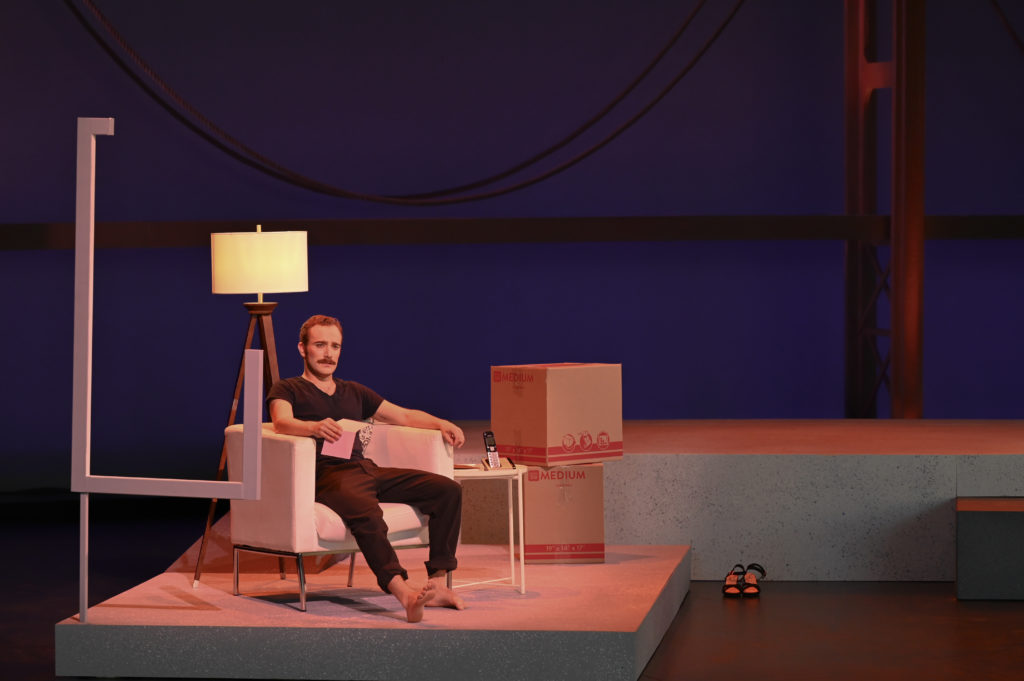
Part one is very much about Charlie, and it sets the ominous background that infuses the opera: the AIDS crisis. For her 2020 DMA dissertation, Cynthia Skelley-Wohlschlager interviewed Heggie, and he had this to say about the opera’s ever-present tragedy and why he wished to include a gay couple from the 1980s.
“There were a lot of younger singers who were looking at the piece and learning it, who had no reference point for what the AIDS crisis was like and how that destroyed families, and how it put a wedge between people, and how much fear there was… I was in my 20s in the 80s, and saw a lot of friends die. I saw their families shun them, and disown them, and saw other families rally and come back together like they never had before. So, it was something that I felt needed to be told.”
The laughs Charlie and Bea have at the expense of Maddy’s Christmas letter morph into deep sadness when Charlie reveals that their mother referred to his lover, Burt, by the wrong name, calling him Curt, this after he’s been with his lover for five years. Baritone Theo Hoffman (Charlie) presented an anxious man, angered by his mother’s forgetfulness at best and deliberate insensitivity at worst. Hoffman’s enunciation is clear and direct, and Charlie’s hurt is unmistakable in his tone as he contrasts Burt’s love with Maddy’s. She provides him with no comfort, no words of hope, and no support. He must face Burt’s illness alone. The aria wraps with an extended C4 across five measures. Hoffman did so without wavering as he sat gently on the note, capturing the simultaneous fear and hopefulness with which Charlie wrestles. Meanwhile, on the other end of the phone, Bea envies the closeness Charlie and Burt share.
A true Broadway takeaway in the Sondheim style, Maddy sings “Daybreak,” the final number of Maddy’s new Broadway show. The tune hews close to the overarching storyline of the missing father/husband. Maddy sings, “No regrets. No more tears. No more lies. No more fears. I’m through crying over you and mourning the past.” Is she singing of her situation or that of the musical in which she stars?
Adriana Zabala, singing the role of Maddy, flows and rolls with the swells of the music. Her sound is full and crisp and loaded with nuance. Maddy is difficult to like, but that doesn’t mean she’s an entirely unsympathetic character. She’s suffered serious trauma, which we learn in detail in Part two. Is she selfish, vain, and a terrible mother? No doubt. Is the stage a place she simply cannot be away from, her refuge, her escape? Absolutely.
A Gershwin-Esque interlude, with loose quotes from “Rhapsody in Blue,” accompanies a quick scene change as the opera moves toward the close of Part one. Conductor Christopher James Ray handles the genre-bending and leaps between Broadway and the opera house seamlessly and continues doing so throughout the show.
The final two scenes feature Maddy and Bea (played by soprano Monica Dewey) in Maddy’s dressing room and Bea and Charlie in San Francisco. In the former, Bea asks about her father, about whom Maddy lies repeatedly when she tells her daughter of his love for her, his untimely death, and that as a couple, they were “the best.” The reminiscing nose dives when Bea brings up Charlie and points out how Maddy has failed to mention him even once. She doesn’t seem to care that Burt is dying, and her son is deep in pain emotionally, and this angers her—Maddy just can’t see beyond herself or the footlights.
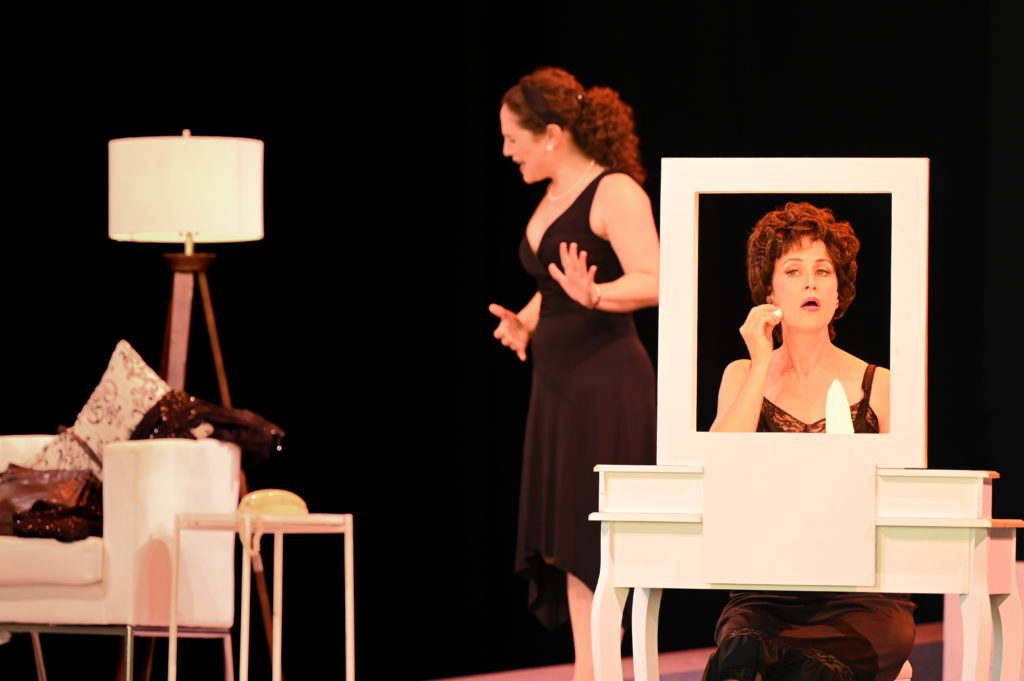
In their duet, “In the months, the years ahead,” Bea tries to break through to Maddy, explaining how bad the AIDS crisis is and that it’s not something abstract; the illness is affecting their family, and Charlie needs their full support. But Maddy hasn’t come to grips with her son’s sexuality and doesn’t see Burt as part of the family. In fact, Bea hints at Maddy’s belief that Burt is the reason Charlie is gay. Dewey is persuasive and unwavering in her plea for Maddy to be the parent she never was. Zabala, in strident, angry bursts, defends herself. The tension between mother and daughter is starkly drawn. Dewey and Zabala shared excellent chemistry and were well-cast, vocally, weaving their lines into a tapestry of argument. While Bea pleads for Maddy to show some self-awareness, Maddy defends her absentee parenting by pointing to the need to care for two children as a single mom. And, indeed, Maddy needed to sacrifice for her children, but where does sacrifice cross the line and become self-centeredness?
The last number of Part one is another duet. “What do you remember about Dad?” sung by Charlie and Bea when Bea visits her brother in San Francisco. Hoffman and Dewey played the scene wistfully. Dewey sings tenderly as she recalls the faintest memories of her Dad. She carries the melody beautifully over pizzicato strings and winds before legato strings fill in the top, and Hoffman joins her with smooth, warm tones. Heggie steeped the duet in Broadway flavor, setting up a slow waltz with conversations happening between the principals and the orchestra.
In their duet, Charlie and Bea remember the soft chair their father sat in, saying it was deep and safe. Charlie remembers watching Saturday morning cartoons with his Dad, and Bea recalls his strong, yet soft voice singing a lullaby about the moon. Brother and sister lionize their dad based on memories, the reality of which even they question.
Part Two – 1996
Part two is set at Christmastime 1996. Burt has died, but not before Maddy visited the couple in San Francisco, where she comforted Burt by singing the lullaby Charlie’s father sang to him: “The Moon Lullaby.” The number begins with ephemeral vocalizations, lifting the audience skyward with its ghostly sound. The lullaby lasts just under two minutes and is so tenderly sung by Zabala it touched the heart and the ear.
The lullaby segues to Maddy announcing her nomination for another Tony Award. She speaks excitedly via phone to Bea about preparations, but her daughter is troubled. Maddy can’t comprehend why, stating she understands Charlie’s misery, but Bea’s remains a mystery. The two hang up, and the ethereal vocalizations return, this time with all three singing from their respective locations. It was otherworldly, with voices separating, joining, weaving, and swirling.
A brief scene change takes the audience inside Maddy’s apartment, where Bea is trying on dresses in front of a full-length mirror, swigging wine from a glass. Maddy is late, or perhaps, as Bea suspects, her mother has forgotten their plan to meet. Bea isn’t doing well. Her insecurities are getting the best of her, her husband has been unfaithful, and her mother’s criticism and ongoing neglect have taken their toll. Her aria, “She’s late,” is a litany of hurt interspersed with sips of wine and ends with Bea toasting her father; “Here’s to you, Daddy. There’s a party tonight, and it won’t be any fun without you.” The aria is one of regret, and Dewey infuses that emotion with mournful bitterness.
Charlie enters with shopping bags, recounting his outing. Hofmann’s voice sparkles with excitement as he tells of stealing hosiery from Patti LuPone. Happy though he is, he catches Bea’s sadness, and attempts to brighten his sister’s mood by giving a mock acceptance speech and jesting about their mother’s penchant for shoes. When Maddy does finally arrive, she’s disappointed to learn Charlie has been helping Bea get dressed; something she wanted to do with her daughter, if only to castigate her about her clothing choices.
The following numbers, “You look lovely, dear,” and “I don’t believe you,” rip the family band-aid off. In “You look lovely, dear,” Maddy informs Charlie and Bea that she intends to acknowledge Charlie and his strength in overcoming adversity (Burt’s death), as well as speaking of what he has taught her about love. There’s little sincerity in any of it. Charlie and Bea aren’t duped, but it makes for a good speech.
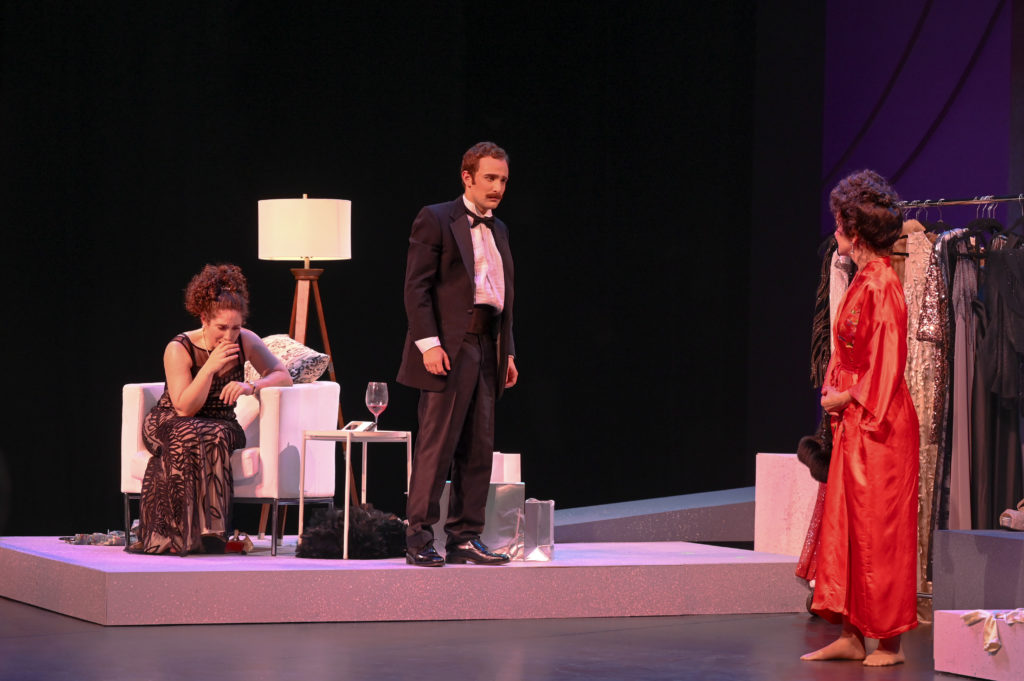
Bea, now thoroughly drunk, mockingly slow-claps Maddy’s acceptance speech and praises her acting ability because that’s what she’s best at, on and off-stage. With her brain awash in alcohol, they spar with vicious words while Charlie attempts to keep the peace. The musical tension ratchets up, and Dewey and Zabala’s tone grows increasingly strident while fear permeates Hoffman’s lines. Here comes the metaphorical train wreck. After, Bea taunts her mother’s selfishness, accusing her of tormenting her father as she does her children. Maddy has the last word, Bea, she says is just like her father, a sad, sorry, drunken mess. The man Charlie and Bea held up as a model father taken too soon was annihilated.
The scenes were intense, with plenty of edge-of-your-seat moments. Hoffman’s declamatory lines when attempting to calm the maelstrom between mother and daughter were crisply sung. Bea’s drunken rage, while justifiable, is terrible to watch. With each word sung, she’s stepping closer and closer to the edge. Dewey and Zabala dazzled in this hyperemotional environment, with neither holding back. They fully immersed the audience in the bitter mother/daughter spat and its devastating conclusion.
As mentioned earlier, Maddy, while tough to like, isn’t someone for the audience to despise; she’s a tragic figure deserving more pity than approbation, and never that more clear than in the final two numbers of Part two. Maddy lays out the very real hardships she dealt with as the wife of an alcoholic whose final act was leaping in front of a train. The glimpse into Maddy’s early life as a wife and parent is dark, and she joins her children in a state of exhausted brokenness. Yet, nothing will stop Madeline Mitchell from going to the Tony Awards, and she gets ready as before. Bea and Charlie do not accompany her.
Part Three – 2006
Maddy passed away in her sleep, but not before finishing the year’s Christmas letter. Maddy’s memorial service is held in a Broadway theater, and Charlie and Bea speak loving words about both their father and mother. The service opens with a reprise of what Cynthia Skelley-Wohlschlager refers to as The Father’s Chair motif, now familiar from the Part one closing duet. Throughout the “Memorial Service” song, all the motifs called out by Skelley-Wohlschlager have recapitulations: the Gossip Motif from the opening letter-reading scene, the Maddy Motif, the Charlie and Burt Love Motif, the So Hard to Be Human, and the Father’s Chair Motif, all show up. A bed of motifs forms the coda of Maddy’s life, as well as the lives of her children, up to that point. Charlie is more at peace than Bea, who recalls the hurts inflicted by her mother, and how she preferred to walk the boards rather than spend time with her children. Though Maddy has hurt both deeply in a myriad of ways, they commend their parents’ should to rest. While Maddy’s death isn’t tragic, it’s death, nonetheless, and what’s opera without someone dying? Broadway tends to have more upbeat conclusions, and Heggie once more pulls from that well with a bittersweet closing, utterly fitting a star who was beloved by all, even those she hurt most.
The scenic design by Janie E. Howland was sparse and geometric, comprising three risers. Charlie mostly occupies the stage right riser, Bea, the riser on stage left, and Maddy, the largest riser in the center. Scene changes required the swapping out of details, such as mirrors, lamps, chairs, racks of clothes, and a lectern, but the riser positions remained the same. The focal point was a scale model of the Golden Gate Bridge, which, at first, appeared to be a painting. However, a further look revealed its three-dimensionality. On the surface, it’s an unambiguous reference to where Charlie lives, but why focus on San Francisco when New York is just as central? (Hartford, not so much.) The bridge, one of the world’s most iconic, “links” Charlie and Bea, physically and metaphorically. Physically, given the position of the risers at the opposing terminuses, and metaphorically because Maddy’s stage position sits dead center between the two sides. She is the swirling water both children must cross while relying on each other because Maddy is so capricious. When Charlie and Bea meet in the middle, so to speak, they can support each other more effectively. This plays out several times: the Part one letter reading, Bea’s visit to San Francisco in the latter half of Part one, the pre-Tony Awards “shoe duet,” and the bombshell revelation. At the show’s conclusion, it’s Maddy’s death that brings them together once more.
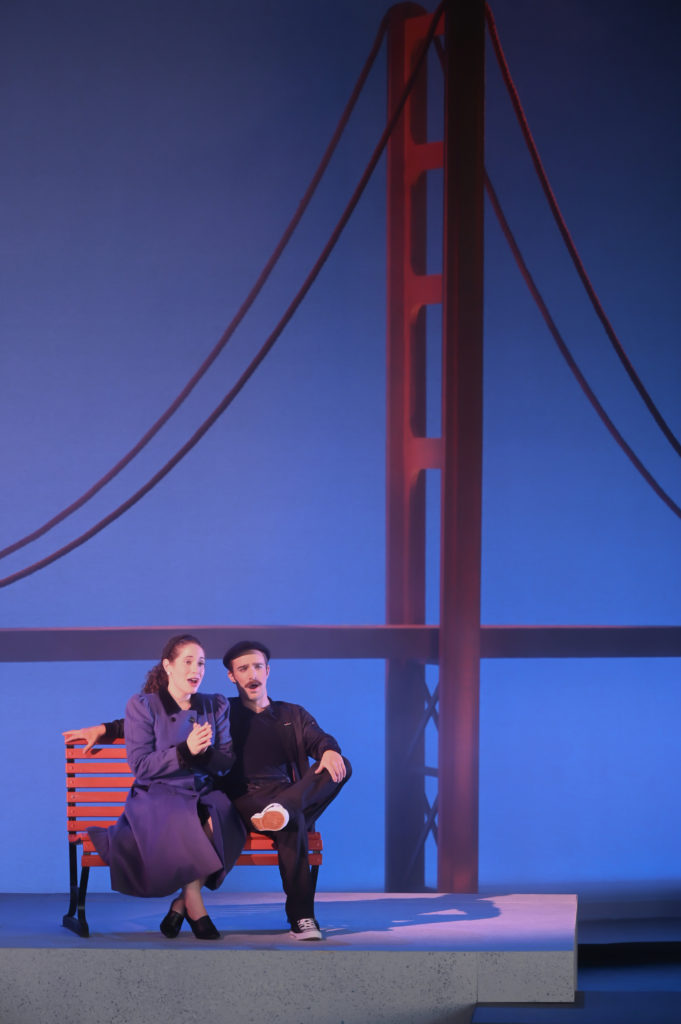
It’s tough to perform in 96-degree (35 degree Celsius) conditions, especially when costuming includes a fur coat, tuxedo, gowns, and other summer-unfriendly attire. Hoffman, Dewey, and Zabala gave 100 percent in sauna-like conditions, and their professionalism and preparedness saw them through with no noticeable miscues or vocal faults.
In front of the stage sat the 11-piece orchestra under the baton of Christopher James Ray. From my vantage point, all looked relatively unfazed by the heat. Ray appeared not to have broken a sweat after waving his arms for 90 minutes as he kept the Berkshire Festival Orchestra focused and tight. His enthusiasm ran high throughout, and this he transmitted to his band, which treated the audience to an unflagging performance. Ninety minutes of music is a lot, especially when the score is an intriguing mix of opera and Broadway. Ray’s pedigree is solid, with experience in both the standard and contemporary repertoire. Currently, he’s Resident Conductor at Opera San José and an assistant with San Francisco Opera. After working with the renowned Bayreuth Festival on productions of many of Wagner’s greatest works, it’s safe to assume the maestro knows the storytelling power inherent in motifs.
The Orchestra showed itself to be top-notch, which should be expected when playing in Tanglewood’s backyard. Clarinetist Diego Vásquez and Oboist/English Horn player Paul Lueders stood out during the quieter, more introspective moments of the opera, particularly within the Father’s Chair Motif, as identified by Skelley-Wohlschlager.
“Three Decembers” is a story about family, finding oneself, and secrets. But, the through-line is one of loss. The children lose their mother to the theater and their father to drinking and suicide. Bea never felt like she had a mother, and her life and marriage disintegrated because of her issues with alcohol. Charlie’s losses match Bea’s, except for the additional, devastating loss of his lover and friends to AIDS. Meanwhile, Maddy lost the love of her children for decades.
What kind of animal is “Three Decembers?” Putting musical styles aside, it’s a devastating tragedy that rips your heart from your chest.
Next up for the Festival is “High on the Ramparts,” a concert celebrating Black composers on Aug. 10, and a three-show run of “Don Giovanni,” August 20-26.



